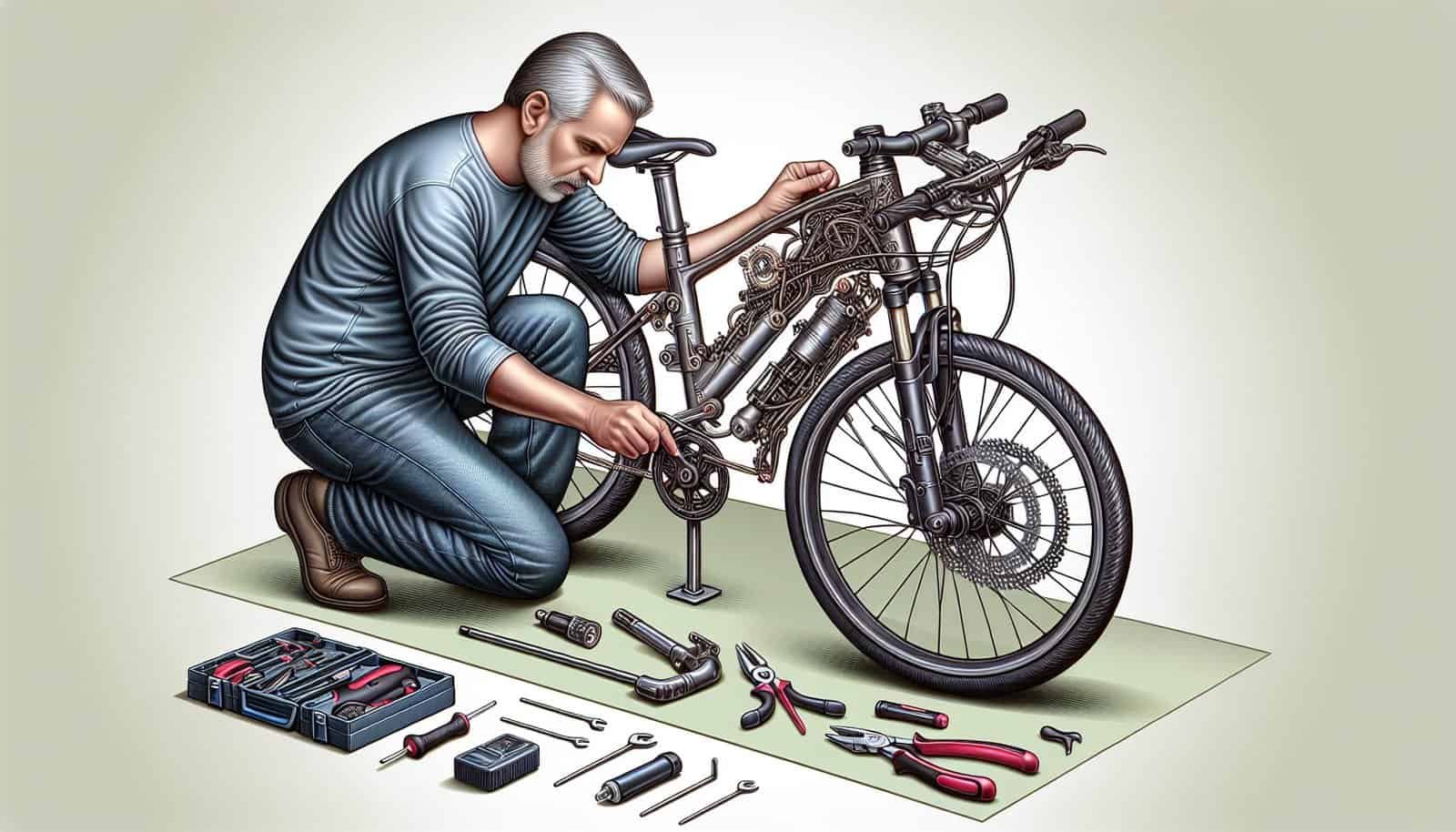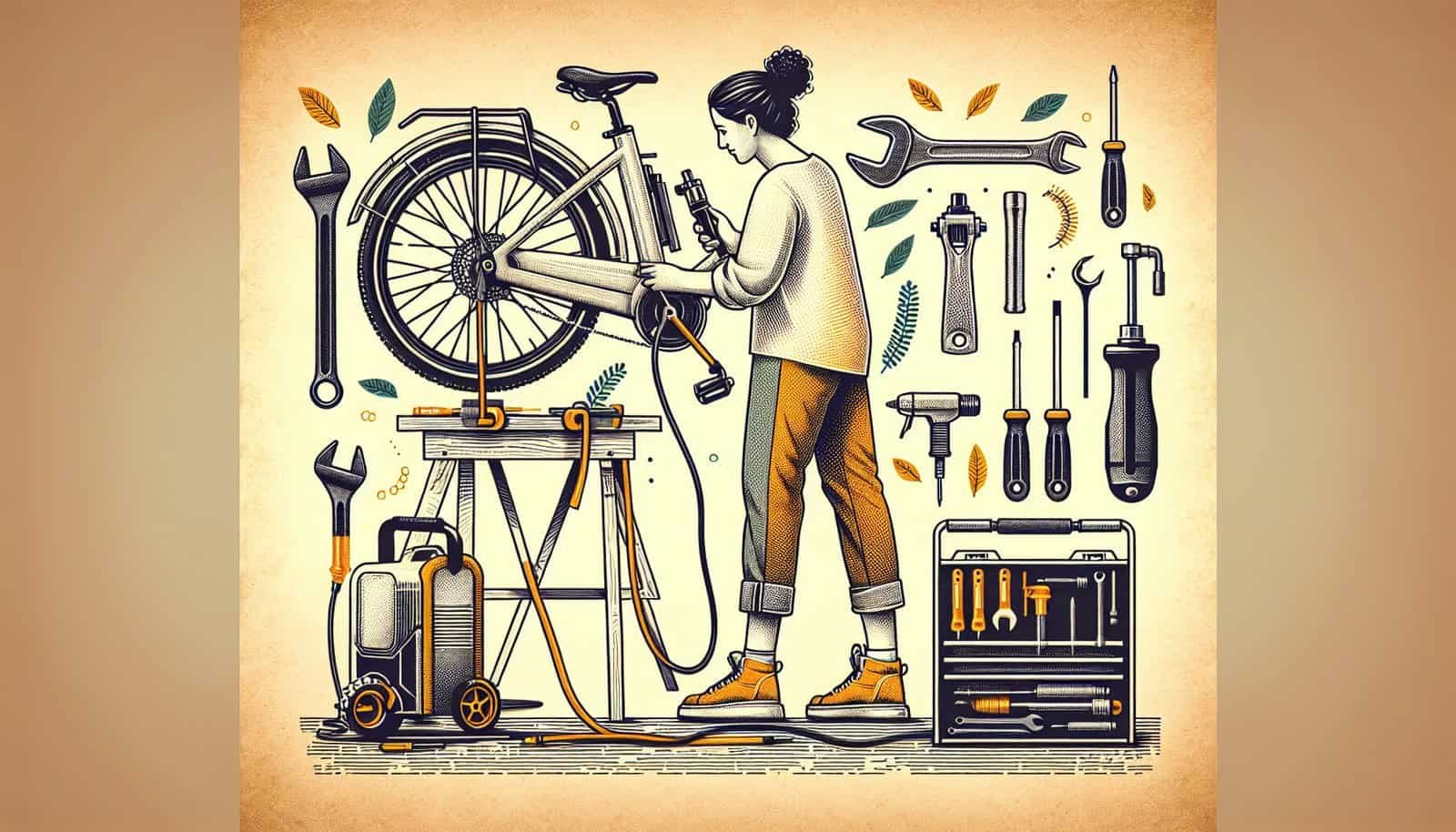Maintaining your electric bike at home is easier than you think! Whether you’re a seasoned rider or new to the world of electric bikes, there are a few maintenance tasks you can easily handle on your own. From checking the tire pressure to cleaning the chain, these simple steps will not only keep your electric bike in top shape but also prolong its lifespan. So why wait? Let’s explore the exciting world of home maintenance for your electric bike!
Cleaning and Inspection
Washing the Bike
Keeping your electric bike clean not only helps it look good but also ensures that dirt and grime do not interfere with its performance. Begin by using a gentle hose spray or a bucket of water to wet the bike. Be cautious not to spray water directly into the motor or battery compartment. Use a sponge or soft brush with mild soap to clean the frame, forks, and other accessible parts. Rinse thoroughly and dry with a clean cloth. Pay extra attention to cleaning areas where debris can accumulate, such as the drivetrain and wheel rims.
Inspecting the Frame
Regularly inspecting the frame of your electric bike can help identify potential issues before they become major problems. Check for any cracks, dents, or signs of damage. Look closely at the welds, particularly around areas that bear weight or experience stress. If you notice any structural issues or suspect damage, it is advisable to consult a professional bike mechanic.
Checking the Cables and Connections
The proper functioning of your electric bike relies on the integrity of its cables and connections. Begin by examining the condition of the cables for any signs of fraying, kinks, or wear. Ensure that all cables are properly attached and secure. Check the connectors for any signs of corrosion or looseness. If you find any problems, it is important to address them promptly to maintain the electrical system’s efficiency and safety.
Examining the Wheels and Tires
The wheels and tires are crucial components of your electric bike that deserve regular attention. Start by checking the tire pressure using a reliable gauge, ensuring it matches the manufacturer’s recommended range. Inspect the tires for any signs of wear, such as bald patches or cuts, that may compromise their grip or puncture resistance. Additionally, check the wheels for any loose or broken spokes, ensuring they spin smoothly and are properly aligned.
Inspecting the Brakes
Properly functioning brakes are essential for your safety while riding. Inspect the brake pads and ensure they have sufficient thickness, replacing them if required. Examine the brake rotors for any signs of warping, scoring, or excessive wear. If your electric bike has hydraulic brakes, check the fluid level to ensure it is within the recommended range. Lastly, test the brakes to ensure they engage and release smoothly, without any excessive play or squeaking noises.
Tire Maintenance
Checking Tire Pressure
Maintaining the correct tire pressure is crucial for optimal performance and safety. Using a tire pressure gauge, check the pressure of each tire regularly. Consult the manufacturer’s guidelines to determine the recommended range. Underinflated tires can affect the bike’s handling and efficiency, while overinflated tires may result in a harsh ride and increased risk of punctures.
Inspecting for Wear and Damage
Regular inspections of your electric bike’s tires are necessary to identify any signs of wear or damage. Examine the tread patterns and sidewalls for cuts, bulges, or any other visible deterioration. Pay attention to any uneven wear patterns, as they may indicate alignment or suspension issues that need professional attention. If you notice any significant wear or damage, consider replacing the tire to maintain optimal performance and safety.
Rotating the Tires
Rotating the tires on your electric bike can help distribute wear more evenly, potentially extending their lifespan. If your bike has interchangeable front and rear tires, swap them periodically. This practice ensures that both tires experience similar levels of wear and can help maintain consistent performance. Consult your bike’s user manual to determine the recommended rotation intervals.
Replacing or Patching a Flat Tire
Experiencing a flat tire can be frustrating, but fortunately, it is a repair that can often be done at home. To repair a flat tire, start by removing the wheel from the bike. Locate the source of the puncture using soapy water or a visual inspection. Depending on the size and location of the puncture, you can use a tire patch kit to fix it or replace the tube entirely if necessary. Ensure that the tire is properly seated and inflated to the recommended pressure before reattaching it to the bike.

Battery Care
Charging the Battery Properly
Proper battery charging is essential to ensure the longevity and performance of your electric bike’s battery. Follow the manufacturer’s guidelines regarding charging methods and durations. Use the provided charger or a compatible one that meets the specifications outlined in the user manual. Avoid overcharging or letting the battery completely discharge, as these practices can negatively impact its lifespan.
Storing the Battery
If you plan to store your electric bike for an extended period, take proper precautions to preserve the battery’s health. Charge the battery to around 60-80% before storing it. Store the battery in a cool, dry place, preferably between 20-25°C (68-77°F), away from direct sunlight and extreme temperature fluctuations. Check the battery periodically and recharge it if the charge level drops significantly to avoid deep discharge.
Cleaning Battery Terminals
Over time, dirt, dust, and corrosion can accumulate on the battery terminals, affecting the electrical connection. Regularly inspect the battery terminals and clean them using a soft cloth or a mild electrical contact cleaner. Ensure that the terminals are dry before reconnecting the battery to prevent any damage to the electrical components.
Inspecting Battery Casing
The battery casing protects the crucial components inside, so it is important to inspect it for any signs of damage. Look for cracks, dents, or any visible impact marks that may compromise the battery’s integrity. If you notice any issues or suspect damage, contact the manufacturer or a professional bike mechanic for further guidance.
Chain and Drivetrain
Cleaning and Lubricating the Chain
Maintaining a clean and well-lubricated chain is vital for optimal performance and longevity. Start by applying a suitable degreaser to remove any built-up dirt and grime. Use a brush or a clean rag to scrub the chain thoroughly, ensuring that all residues are removed. After cleaning, apply a high-quality chain lubricant, ensuring it is evenly distributed. Wipe off any excess lubricant to prevent attracting more dirt and ensure a smooth, efficient chain movement.
Checking Chain Tension
An improperly tensioned chain can cause poor shifting, increased wear, and even chain slippage. Check the chain tension regularly by applying light pressure with your fingers at the midpoint between the two sprockets. Ideally, the chain should have a slight amount of slack while remaining taut. Consult your bike’s user manual for the recommended tension range and make adjustments as necessary.
Inspecting Chain for Wear
Regularly inspecting your electric bike’s chain can help identify signs of wear before they lead to potential drivetrain issues. Look for elongation, indicated by visible stretching or the ability to pull the chain away from the tooth of the rear sprocket. Additionally, inspect the chain’s wear indicators, usually present on the links. If the wear exceeds the manufacturer’s recommendations or you notice any significant damage, it is advisable to replace the chain promptly.
Inspecting Gears
Inspecting the gears of your electric bike can help identify any issues that may affect shifting performance. Look for worn or damaged teeth on both the chainrings and the rear cassette. If you notice any irregularities or signs of excessive wear, it may be necessary to replace the worn component. Ensure that the gears are properly aligned and engage smoothly during shifting.
Replacing Chain or Drivetrain Components
If your inspections reveal significant wear, damage, or poor performance of the chain or drivetrain components, it may be necessary to replace them. Consult a professional bike mechanic to ensure proper installation and compatibility with your electric bike. Replacing worn components promptly can help prevent further damage and extend the overall lifespan of your drivetrain.

Brake System
Adjusting Brake Pads
Properly adjusted brake pads are essential for reliable and safe braking performance. Start by inspecting the brake pads for wear, ensuring they have sufficient thickness. If necessary, follow the manufacturer’s instructions to adjust the position of the brake pads, allowing them to make full contact with the braking surface. Ensure that the pads are aligned symmetrically and do not rub against the tire or rim.
Inspecting Brake Rotors
Inspecting the brake rotors is necessary to identify any signs of wear, warping, or damage. Examine the rotor surface for deep grooves, scoring, or discoloration. If you notice any irregularities or suspect compromised braking performance, it may be necessary to replace the brake rotor. Ensure that the rotors are properly aligned and securely fastened.
Checking Brake Fluid Levels (if applicable)
If your electric bike is equipped with hydraulic brakes, it is important to check the brake fluid levels regularly. Refer to the manufacturer’s guidelines for the correct fluid and procedures. Ensure that the fluid level is within the recommended range, topping up if necessary. If you notice a significant decrease in fluid levels or suspect any fluid leaks, it is advisable to seek professional assistance.
Bleeding the Brakes (if applicable)
Over time, air bubbles can accumulate in the hydraulic brake system, resulting in reduced braking performance. Bleeding the brakes involves removing the air from the system and replacing it with fresh brake fluid. If you notice spongy or inconsistent brake feel, consult a professional bike mechanic to perform the necessary bleeding procedure. It is essential to follow the manufacturer’s guidelines and use the recommended tools and techniques.
Electronics and Wiring
Inspecting and Tightening Connections
Regularly inspecting and tightening the electrical connections on your electric bike is crucial for maintaining reliable and safe operation. Check all visible connections, such as those between the battery, motor, display, and controller. Look for any signs of corrosion, looseness, or damage. If you notice any issues, use the appropriate tools to securely tighten the connections or consult a professional if necessary.
Checking Lights and Signals
Properly functioning lights and signals ensure your visibility and safety while riding your electric bike. Test all lights, including headlights, taillights, brake lights, and turn signals, to ensure they are functioning correctly. Replace any burnt-out bulbs or faulty components promptly to maintain optimal visibility. If you notice any persistent electrical issues, consult a professional to diagnose and repair the problem.
Inspecting the Display and Controls
The display and controls of your electric bike provide essential information and allow you to operate various features. Regularly inspect the display screen for any visible damage, such as cracks or water ingress. Test all control buttons, switches, and levers to ensure they respond accurately and smoothly. If you experience any malfunctions or suspect any issues, contact the manufacturer or a professional bike mechanic for further assistance.
Troubleshooting and Repairing Basic Electrical Issues
While some electrical issues may require professional assistance, there are basic troubleshooting steps you can undertake at home. If you encounter an electrical problem, such as a loss of power or an unresponsive component, start by checking the fuses and circuit breakers. Ensure that all connections are secure and inspect the wiring for any signs of damage or loose connections. If the issue persists, it is advisable to consult a professional for further diagnosis and repair.

Suspension
Inspecting Suspension Fork (if applicable)
If your electric bike is equipped with a suspension fork, regular inspections are necessary to ensure optimal performance and safety. Check for any signs of oil leakage, visible damage, or excessive play in the suspension fork. Test the fork’s responsiveness and smoothness by compressing it and listening for any unusual noises. If you notice any issues or suspect any damage, consult a professional bike mechanic for further examination and servicing.
Cleaning and Lubricating Suspension Components
Maintaining clean and well-lubricated suspension components is essential for smooth operation and durability. Start by cleaning the suspension fork stanchions and shock absorber elements using a soft brush or cloth. Remove any built-up dirt or debris that could affect their function. After cleaning, apply a suitable suspension fork or shock lubricant as recommended by the manufacturer. Follow the instructions carefully to ensure proper application and distribution of the lubricant.
Adjusting Suspension Settings
Depending on your riding style and preferences, you may need to adjust the suspension settings of your electric bike. Refer to the manufacturer’s guidelines and user manual for specific recommendations regarding sag, compression, and rebound settings. Experiment with different suspension settings to find the optimal balance between comfort, control, and efficiency. Make adjustments gradually and note any changes in the bike’s handling characteristics.
Saddle and Grips
Checking Saddle Position and Tightness
The position and tightness of your electric bike’s saddle play a significant role in ensuring your comfort and control. Regularly check the saddle’s position and alignment, ensuring it is adjusted to your desired height and tilt. Secure the saddle firmly to prevent any unwanted movement during riding. Periodically test the saddle’s tightness by gripping it and applying pressure, checking for any noticeable shifting or play.
Inspecting Saddle for Wear
Over time, the saddle of your electric bike may show signs of wear or damage. Inspect the saddle’s surface for any cracks, tears, or excessive wear. Pay attention to the areas where your body makes contact with the saddle, as they are more prone to wear. If you notice any significant damage or discomfort, consider replacing the saddle to maintain optimal comfort and support.
Replacing Grips if Worn or Damaged
The grips on your electric bike’s handlebars ensure a secure and comfortable grip while riding. Inspect the grips regularly for any signs of wear, fraying, or damage. If the grips feel slippery or show significant wear, it is advisable to replace them promptly. There is a wide range of grips available, so choose ones that suit your preferences and riding style.

Lights and Reflectors
Checking and Replacing Bulbs (if applicable)
Properly functioning lights are crucial for your visibility and safety on the road. If your electric bike has replaceable bulbs, regularly check them for proper operation. Inspect all bulbs, including headlights, taillights, brake lights, and turn signals. Replace any bulbs that are burnt out or no longer functioning. Ensure that you use bulbs with the correct specifications to maintain proper illumination.
Cleaning and Adjusting Reflectors
Reflectors on your electric bike play a crucial role in ensuring your visibility, particularly during low-light conditions. Regularly inspect the reflectors for dirt, dust, or other contaminants that may affect their effectiveness. Clean the reflectors using a gentle cloth or sponge and mild soapy water. Ensure they are properly aligned and securely attached to the bike to maximize their visibility.
Inspecting Light Mounts
The mounts that secure your electric bike’s lights and reflectors should be inspected regularly to ensure their stability and effectiveness. Check all mounts for any signs of damage or wear, ensuring they are securely fastened to the bike frame. If you notice any issues or suspect any compromised mounting, consult a professional bike mechanic for further examination and appropriate repairs.
Storage and Protection
Properly Storing the Electric Bike
When not in use for an extended period, proper storage practices can help maintain your electric bike’s condition and performance. Store the bike in a dry and secure location, away from extreme temperatures, direct sunlight, and humidity. Ideally, elevate the bike off the ground to prevent the tires from developing flat spots. Avoid storing the bike near corrosive substances or in environments prone to pests.
Protecting the Bike from Elements
Exposure to the elements can accelerate the wear and deterioration of your electric bike’s components. Whenever possible, protect the bike from rain, snow, and excessive sunlight. Consider using a bike cover or storing the bike indoors to shield it from moisture, UV rays, and other environmental factors that can cause damage.
Using Bike Covers
Using a bike cover provides an additional layer of protection against dust, dirt, and moisture. Invest in a high-quality cover specifically designed for electric bikes. Before covering the bike, ensure that it is clean and dry to prevent any trapped moisture or potential damage. Secure the cover properly to prevent it from flapping in the wind, potentially causing scratches or other damage.
Preventing Theft
Electric bikes are valuable and attractive targets for theft. Taking appropriate measures to prevent theft can help safeguard your investment. Always lock your electric bike when leaving it unattended, even if it is just for a short period. Use high-quality locks, such as sturdy U-locks or heavy-duty bicycle chains, and secure the bike to a fixed structure whenever possible. Consider additional anti-theft measures, such as GPS trackers or bike alarm systems, to increase the chances of recovering your bike if it is stolen.
By following these maintenance tasks at home, you can keep your electric bike in excellent condition and ensure a safe and enjoyable riding experience. Regular cleaning, inspection, and upkeep of critical components will help extend the lifespan of your electric bike, maximize performance, and minimize the risk of unexpected issues on the road. Remember to consult your bike’s user manual for specific guidelines and always reach out to professionals for assistance when needed. Happy riding!


